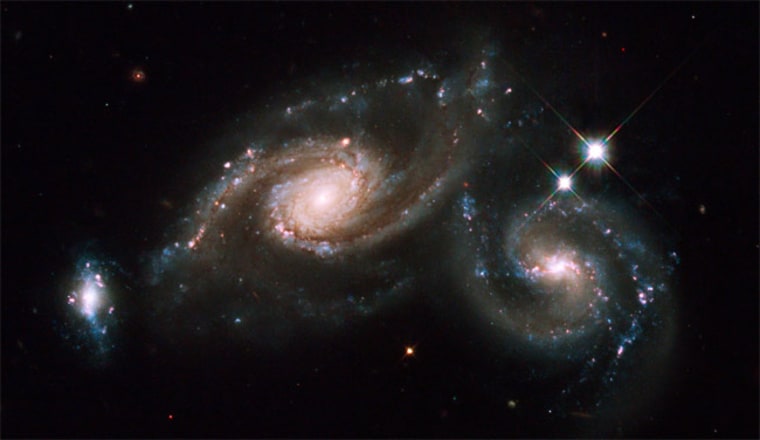The Hubble Space Telescope has photographed a group of colliding galaxies that won a cosmic popularity contest voted on by the public.
The snapshot features Arp 274 (also known as NGC 5679), a galaxy smashup going on as three distant galaxies merge into one, drawn in by their mutual gravitational attraction. On April 1 and 2, Hubble's Wide Field Planetary Camera 2 snapped the photogenic site, located about 400 million light-years away.
Arp 274 won the Space Telescope Science Institute's "You Decide" competition, which opened up a poll to determine the target of the next space portrait in honor of the "100 Hours of Astronomy" project, part of the ongoing International Year of Astronomy. The striking object received 67,021 votes out of the nearly 140,000 votes cast in the contest. Voting ended on March 1.
The two biggest galaxies are spirals that appear mostly intact. The tiny third galaxy shows more signs of disruption.
Two of the three galaxies appear to be forming new stars at a high rate, as evidenced by the bright blue knots of star formation that are strung along the arms of the galaxy on the right and along the small galaxy on the left.
The picture was made with blue, visible, and infrared light filters, combined with a filter that isolates hydrogen emission. The colors in the image reflect the intrinsic color of the different stellar populations that make up the galaxies.
Slideshow 12 photos
Month in Space: January 2014
Yellowish older stars can be seen in the central bulge of each galaxy. A bright central cluster of stars pinpoint each nucleus. Younger blue stars trace the spiral arms, along with pinkish nebulae that are illuminated by new star formation. Interstellar dust is silhouetted against the starry population. A pair of foreground stars inside our own Milky Way are at the far right.
NASA launched the Hubble Space Telescope in April 1990. Since then, the observatory has spent nearly 19 years scanning the depths of the universe and returning stunning views to scientists and the public on Earth.
Four NASA space shuttle crews have visited the space telescope to make repairs and upgrades during its orbital life. The fifth and last overhaul for Hubble is currently slated to launch on May 12. That mission includes five spacewalks aimed at extending Hubble's lifetime through at least 2013.

